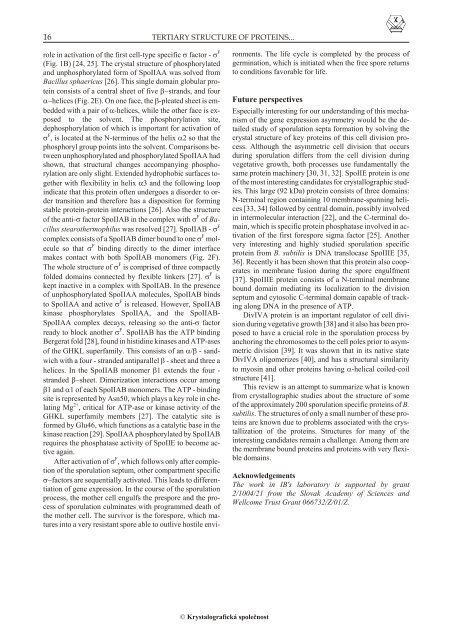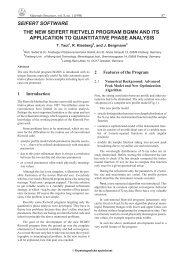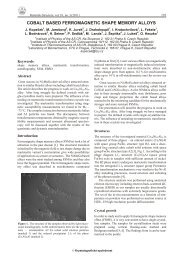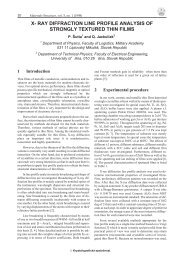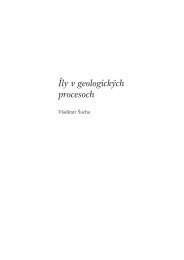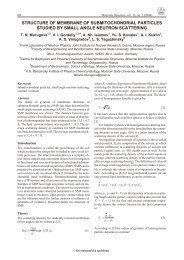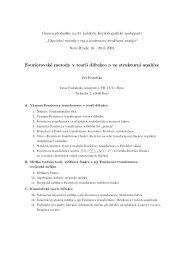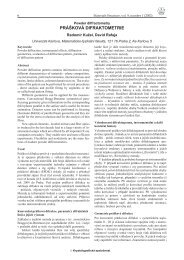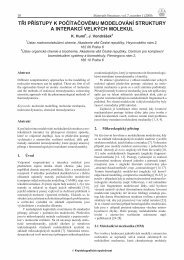tertiary structure of proteins involved in the bacillus subtilis cell ...
tertiary structure of proteins involved in the bacillus subtilis cell ...
tertiary structure of proteins involved in the bacillus subtilis cell ...
You also want an ePaper? Increase the reach of your titles
YUMPU automatically turns print PDFs into web optimized ePapers that Google loves.
16 TERTIARY STRUCTURE OF PROTEINS...<br />
role <strong>in</strong> ac ti va tion <strong>of</strong> <strong>the</strong> first <strong>cell</strong>-type spe cific fac tor - F<br />
(Fig. 1B) [24, 25]. The crys tal struc ture <strong>of</strong> phosphorylated<br />
and unphosphorylated form <strong>of</strong> SpoIIAA was solved from<br />
Ba cil lus sphaericus [26]. This s<strong>in</strong> gle do ma<strong>in</strong> glob u lar pro -<br />
te<strong>in</strong> con sists <strong>of</strong> a cen tral sheet <strong>of</strong> five strands, and four<br />
he li ces (Fig. 2E). On one face, <strong>the</strong> -pleated sheet is em -<br />
bed ded with a pair <strong>of</strong> -he li ces, while <strong>the</strong> o<strong>the</strong>r face is ex -<br />
posed to <strong>the</strong> sol vent. The phosphorylation site,<br />
de pho sphorylation <strong>of</strong> which is im por tant for ac ti va tion <strong>of</strong><br />
F , is lo cated at <strong>the</strong> N-ter mi nus <strong>of</strong> <strong>the</strong> he lix 2 so that <strong>the</strong><br />
pho spho ryl group po<strong>in</strong>ts <strong>in</strong>to <strong>the</strong> sol vent. Com par i sons be -<br />
tween unphosphorylated and phosphorylated SpoIIAA had<br />
shown, that struc tural changes ac com pa ny <strong>in</strong>g phospho -<br />
rylation are only slight. Ex tended hy dro pho bic sur faces to -<br />
ge<strong>the</strong>r with flex i bil ity <strong>in</strong> he lix 3 and <strong>the</strong> fol low <strong>in</strong>g loop<br />
<strong>in</strong> di cate that this pro te<strong>in</strong> <strong>of</strong> ten un der goes a dis or der to or -<br />
der tran si tion and <strong>the</strong>re fore has a dis po si tion for form <strong>in</strong>g<br />
sta ble pro te<strong>in</strong>-pro te<strong>in</strong> <strong>in</strong> ter ac tions [26]. Also <strong>the</strong> struc ture<br />
<strong>of</strong> <strong>the</strong> anti- fac tor SpoIIAB <strong>in</strong> <strong>the</strong> com plex with F <strong>of</strong> Ba -<br />
cil lus stearo<strong>the</strong>rmophilus was re solved [27]. SpoIIAB - F<br />
com plex con sists <strong>of</strong> a SpoIIAB dimer bound to one F mol -<br />
e cule so that F b<strong>in</strong>d <strong>in</strong>g di rectly to <strong>the</strong> dimer <strong>in</strong> ter face<br />
makes con tact with both SpoIIAB mono mers (Fig. 2F).<br />
The whole struc ture <strong>of</strong> F is com prised <strong>of</strong> three com pactly<br />
folded do ma<strong>in</strong>s con nected by flex i ble l<strong>in</strong>k ers [27]. F is<br />
kept <strong>in</strong> ac tive <strong>in</strong> a com plex with SpoIIAB. In <strong>the</strong> pres ence<br />
<strong>of</strong> unphosphorylated SpoIIAA mol e cules, SpoIIAB b<strong>in</strong>ds<br />
to SpoIIAA and ac tive F is re leased. How ever, SpoIIAB<br />
k<strong>in</strong>ase phos phory lates SpoIIAA, and <strong>the</strong> SpoIIAB-<br />
SpoIIAA com plex de cays, re leas <strong>in</strong>g so <strong>the</strong> anti- fac tor<br />
ready to block an o<strong>the</strong>r F . SpoIIAB has <strong>the</strong> ATP b<strong>in</strong>d <strong>in</strong>g<br />
Bergerat fold [28], found <strong>in</strong> histid<strong>in</strong>e k<strong>in</strong> ases and ATP-ases<br />
<strong>of</strong> <strong>the</strong> GHKL superfamily. This con sists <strong>of</strong> an / - sand -<br />
wich with a four - stranded antiparallel - sheet and three a<br />
he li ces. In <strong>the</strong> SpoIIAB mono mer 1 ex tends <strong>the</strong> four -<br />
stranded sheet. Dimerization <strong>in</strong>teractions occur among<br />
1 and 1 <strong>of</strong> each SpoIIAB mono mers. The ATP - b<strong>in</strong>d <strong>in</strong>g<br />
site is rep re sented by Asn50, which plays a key role <strong>in</strong> che -<br />
lat<strong>in</strong>g Mg 2+ , crit i cal for ATP-ase or k<strong>in</strong>ase ac tiv ity <strong>of</strong> <strong>the</strong><br />
GHKL superfamily mem bers [27]. The cat a lytic site is<br />
formed by Glu46, which func tions as a cat a lytic base <strong>in</strong> <strong>the</strong><br />
k<strong>in</strong>ase re ac tion [29]. SpoIIAA phosphorylated by SpoIIAB<br />
re quires <strong>the</strong> phosphatase ac tiv ity <strong>of</strong> SpoIIE to be come ac -<br />
tive aga<strong>in</strong>.<br />
After activation <strong>of</strong> F , which fol lows only af ter com ple -<br />
tion <strong>of</strong> <strong>the</strong> sporulation sep tum, o<strong>the</strong>r com part ment spe cific<br />
fac tors are se quen tially ac ti vated. This leads to dif fer en -<br />
ti a tion <strong>of</strong> gene ex pres sion. In <strong>the</strong> course <strong>of</strong> <strong>the</strong> sporulation<br />
pro cess, <strong>the</strong> mo<strong>the</strong>r <strong>cell</strong> en gulfs <strong>the</strong> prespore and <strong>the</strong> pro -<br />
cess <strong>of</strong> sporulation cul mi nates with pro grammed death <strong>of</strong><br />
<strong>the</strong> mo<strong>the</strong>r <strong>cell</strong>. The sur vi vor is <strong>the</strong> forespore, which ma -<br />
tures <strong>in</strong>to a very re sis tant spore able to out live hos tile en vi -<br />
ron ments. The life cy cle is com pleted by <strong>the</strong> pro cess <strong>of</strong><br />
ger mi na tion, which is <strong>in</strong>i ti ated when <strong>the</strong> free spore re turns<br />
to con di tions fa vor able for life.<br />
Future perspectives<br />
Es pe cially <strong>in</strong> ter est <strong>in</strong>g for our un der stand <strong>in</strong>g <strong>of</strong> this mech a -<br />
nism <strong>of</strong> <strong>the</strong> gene ex pres sion asym me try would be <strong>the</strong> de -<br />
tailed study <strong>of</strong> sporulation septa for ma tion by solv <strong>in</strong>g <strong>the</strong><br />
crys tal struc ture <strong>of</strong> key pro te<strong>in</strong>s <strong>of</strong> this <strong>cell</strong> di vi sion pro -<br />
cess. Al though <strong>the</strong> asym met ric <strong>cell</strong> di vi sion that oc curs<br />
dur <strong>in</strong>g sporulation dif fers from <strong>the</strong> <strong>cell</strong> di vi sion dur <strong>in</strong>g<br />
veg e ta tive growth, both pro cesses use fun da men tally <strong>the</strong><br />
same pro te<strong>in</strong> ma ch<strong>in</strong> ery [30, 31, 32]. SpoIIE pro te<strong>in</strong> is one<br />
<strong>of</strong> <strong>the</strong> most <strong>in</strong> ter est <strong>in</strong>g can di dates for crys tal lo graphic stud -<br />
ies. This large (92 kDa) pro te<strong>in</strong> con sists <strong>of</strong> three do ma<strong>in</strong>s:<br />
N-ter mi nal re gion con ta<strong>in</strong> <strong>in</strong>g 10 mem brane-span n<strong>in</strong>g he li -<br />
ces [33, 34] fol lowed by cen tral do ma<strong>in</strong>, pos si bly <strong>in</strong> volved<br />
<strong>in</strong> <strong>in</strong>termolecular <strong>in</strong> ter ac tion [22], and <strong>the</strong> C-ter mi nal do -<br />
ma<strong>in</strong>, which is spe cific pro te<strong>in</strong> phosphatase <strong>in</strong> volved <strong>in</strong> ac -<br />
ti va tion <strong>of</strong> <strong>the</strong> first forespore sigma fac tor [25]. An o<strong>the</strong>r<br />
very <strong>in</strong> ter est <strong>in</strong>g and highly stud ied sporulation spe cific<br />
pro te<strong>in</strong> from B. <strong>subtilis</strong> is DNA translocase SpoIIIE [35,<br />
36]. Re cently it has been shown that this pro te<strong>in</strong> also co op -<br />
er ates <strong>in</strong> mem brane fu sion dur <strong>in</strong>g <strong>the</strong> spore en gulf ment<br />
[37]. SpoIIIE pro te<strong>in</strong> con sists <strong>of</strong> a N-ter mi nal mem brane<br />
bound do ma<strong>in</strong> me di at <strong>in</strong>g its lo cal iza tion to <strong>the</strong> di vi sion<br />
sep tum and cytosolic C-ter mi nal do ma<strong>in</strong> ca pa ble <strong>of</strong> track -<br />
<strong>in</strong>g along DNA <strong>in</strong> <strong>the</strong> pres ence <strong>of</strong> ATP.<br />
DivIVA pro te<strong>in</strong> is an im por tant reg u la tor <strong>of</strong> <strong>cell</strong> di vi -<br />
sion dur <strong>in</strong>g veg e ta tive growth [38] and it also has been pro -<br />
posed to have a cru cial role <strong>in</strong> <strong>the</strong> sporulation pro cess by<br />
an chor <strong>in</strong>g <strong>the</strong> chro mo somes to <strong>the</strong> <strong>cell</strong> poles prior to asym -<br />
met ric di vi sion [39]. It was shown that <strong>in</strong> its na tive state<br />
DivIVA oligomerizes [40], and has a struc tural sim i lar ity<br />
to my o s<strong>in</strong> and o<strong>the</strong>r pro te<strong>in</strong>s hav <strong>in</strong>g -helical coiled-coil<br />
struc ture [41].<br />
This re view is an at tempt to sum ma rize what is known<br />
from crys tal lo graphic stud ies about <strong>the</strong> struc ture <strong>of</strong> some<br />
<strong>of</strong> <strong>the</strong> ap prox i mately 200 sporulation spe cific pro te<strong>in</strong>s <strong>of</strong> B.<br />
<strong>subtilis</strong>. The struc tures <strong>of</strong> only a small num ber <strong>of</strong> <strong>the</strong>se pro -<br />
te<strong>in</strong>s are known due to prob lems as so ci ated with <strong>the</strong> crys -<br />
tal li za tion <strong>of</strong> <strong>the</strong> pro te<strong>in</strong>s. Struc tures for many <strong>of</strong> <strong>the</strong><br />
<strong>in</strong>terest<strong>in</strong>g candidates rema<strong>in</strong> a challenge. Among <strong>the</strong>m are<br />
<strong>the</strong> mem brane bound pro te<strong>in</strong>s and pro te<strong>in</strong>s with very flex i -<br />
ble do ma<strong>in</strong>s.<br />
Acknowledgements<br />
The work <strong>in</strong> IB's lab o ra tory is sup ported by grant<br />
2/1004/21 from <strong>the</strong> Slo vak Acad emy <strong>of</strong> Sci ences and<br />
Wellcome Trust Grant 066732/Z/01/Z.<br />
Krystalografická spoleènost


